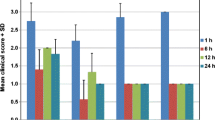Abstract
· Background: FK506 has been used for treatment of cell-mediated immune disorders such as graft rejection in transplantation or Behçet disease. To evaluate the effectiveness of FK506 in another ocular disease model, we injected FK506 in rats with experimental allergic/immune-mediated blepharo conjunctivitis (EAC) the induction mechanism of which depends on cell-mediated immunity. · Methods: Lewis rats were immunized with ovalbumin (OVA) in emulsion of complete Freund’s adjuvant (CFA). We injected 2 (n=6), 20 (n=6) or 200 (n=5) µg of FK506 intramuscularly daily from the day of immunization (day 0) to day 6. Control rats were not treated with FK506 (n=4). In addition, we injected 200 µg of FK506 from day 7 to day 13 (n=12) to compare the timing of FK506 administration (day 0 to day 6, n=12; control, n=12). Twenty-one days after immunization, all rats were challenged with OVA by eye drops, and 24 h later they were killed after clinical evaluation and their eyes, blood and draining lymph nodes were harvested for histology, antibody titers and proliferation assay or flow cytometric analysis. In another set of experiments, rats that had received OVA-primed lymph node cells did (n=9) or did not (n=9) receive additional FK506 by injection daily for 4 days. Four days after transfer, these rats were challenged with OVA and evaluated as mentioned. To investigate possible suppression of disease by topical administration of FK506, both actively immunized and passively immunized rats received OVA together with 0.3% (weight/volume) of FK506 (n=16) or vehicle (n=10) by eye drops and 24 h after challenge, rats were evaluated as mentioned. · Results: Development of disease, induced by either active or passive immunization, was inhibited in the group treated with 200 µg of FK506, regardless of timing of administration. Cellular proliferative responses to OVA were inhibited only in this group. Flow cytometry demonstrated a decrease of about 20% in the proportion of all cells made up by CD4-positive T cells. Topical administration of FK506 inhibited the development of EAC, though not significantly. · Conclusions: Systemic treatment with 200 µg of FK506 either in the induction or the effector phase inhibits the development of EAC in Lewis rats. Topical administration is not so effective as systemic administration.
Similar content being viewed by others
Author information
Authors and Affiliations
Additional information
Received: 28 October 1997 Revised version received: 16 January 1998 Accepted: 26 February 1998
Rights and permissions
About this article
Cite this article
Iwamoto, H., Yoshida, H., Yoshida, O. et al. Inhibitory effects of FK506 on the development of experimental allergic/immune-mediated blepharoconjunctivitis in Lewis rats by systemic but not by topical administration. Graefe's Arch Clin Exp Ophthalmol 237, 407–414 (1999). https://doi.org/10.1007/s004170050252
Issue Date:
DOI: https://doi.org/10.1007/s004170050252




